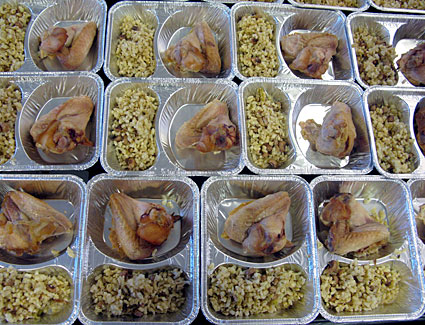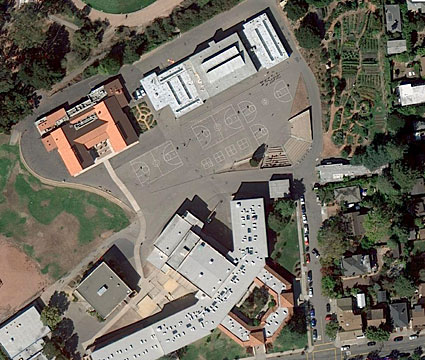Part 2 of Cafeteria Confidential: Berkeley, in which Ed Bruske reports on his recent week-long, firsthand look at how Berkeley, Calif., schools part ways from the typical school diet of frozen, industrially processed convenience foods. Cross-posted from The Slow Cook. And check out the rest of the Cafeteria Confidential series.
Eric Weaver’s son is a freshman in college now. Back when he was in kindergarten, Weaver volunteered at his school, where he couldn’t help noticing that the kids were sneaking into the teachers’ snacks.
Not only were kids hungry because they hadn’t eaten breakfast, Weaver discovered, but what the schools were serving them for lunch was hardly appetizing. “It was atrocious,” Weaver says. “They had this grilled cheese heated in a plastic wrapper that was all mush. Corn dogs. The peanut butter and jelly was just crackers smeared with this stuff.”
An appeals attorney in Berkeley, Calif., Weaver started talking to other parents, and they got busy. One mother conducted her own survey and found that half the food served at lunch wound up in the garbage. “The kids would eat just enough to beat back the hunger, then throw the rest in the trash.”
Just to show that kids would eat healthier food if given a chance, another parent started serving fresh, homemade soup and bread at one of Berkeley’s elementary schools. Parents at another elementary school started a breakfast program, serving bagels once a week.
“We said, ‘If you make good, healthy food, they will eat it,'” Weaver recalls.
So began a long campaign to change the food served to the 9,100 children in the Berkeley Unified School District, from industrially processed convenience foods to what may now constitute the most advanced public school food program in the nation, in which meals are cooked from scratch using fresh ingredients every day.
“Treat kids with respect, they will show you respect”
It was a bumpy road at times. The biggest resistance came from the school system’s food service director. “When I asked why the kids weren’t being fed breakfast, I ran into a whole bunch of rigmarole,” he says. “The food services director was completely hostile. She argued that better food was too expensive and the kids wouldn’t eat it.”
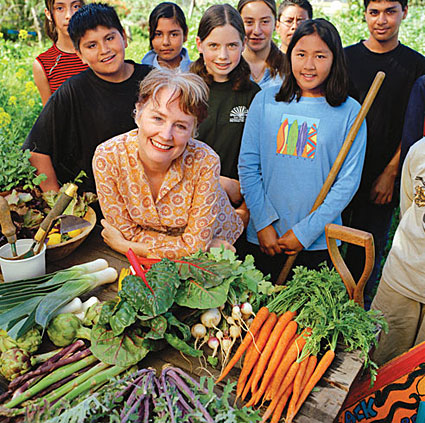 Alice Waters and MLK Jr. middle school students in the Edible Schoolyard.(Edible Schoolyard photo)And yet the campaign caught fire. Berkeley chef Alice Waters was involved. “She had a parallel project. Our ideas were sort of based on the things she wanted,” reports Weaver. “But we were working within the confines of a school budget.”
Alice Waters and MLK Jr. middle school students in the Edible Schoolyard.(Edible Schoolyard photo)And yet the campaign caught fire. Berkeley chef Alice Waters was involved. “She had a parallel project. Our ideas were sort of based on the things she wanted,” reports Weaver. “But we were working within the confines of a school budget.”
It might seem hard to believe that such bad food could be served in schools within blocks of Waters’s famed Chez Panisse restaurant, where she started a food revolution all about cooking with fresh, local ingredients. But until just five years ago, the food in Berkeley cafeterias was no better than in most schools around the country: Chicken nuggets, pizza pockets, canned fruits and vegetables.
At one point, according to Weaver, Waters visited the schools “and she said the cafeterias looked like prisons. So we put linens on the tables and vases for flowers. I was there to see what happened. The kids came in and said, ‘Wow! Look at this!’
“Our theory was, if you treat kids with respect, they will show you respect.”
Other important players were drawn in as well, such as Tom Bates, a former Berkeley city supervisor and longtime California assemblyman, now Berkeley’s mayor. He recalls getting a telephone call one day from the man who was then superintendent of schools, John McLaughlin, about a meeting he’d just had with a parent furious about the food being served in the cafeteria. Bates said he agreed to meet with the parent “who was upset with what was going on, the corn dogs and all the crappy food his kid was getting.” A committee was formed, and Bates and others began meeting with the superintendent to go over menus and try to improve the meals.
The committee, initially formed in 1997, came to be called the “Superintendent’s Group.” It met monthly with parents, the school board president and the head of school nutrition services. The Berkeley-based Center for Ecoliteracy also joined in, and in 1999 it received a three-year grant from the U.S. Department of Agriculture to improve school food and create teaching gardens. That same year, the school board adopted a food policy that established a formal committee — the Child Nutrition Advisory Committee — to oversee changes in the school district’s food services. The CNAC was composed of 29 members, including five students. They finally convinced the district’s food services director that the food had to change.
Schools Superintendent McLaughlin was succeeded by Michele Lawrence, who admits “healthy food was never on my list as a priority of things I needed to take care of” when she first took the job. But she had her own personal epiphany. “I was pulling up to one of those photomats in my car to drop off some film, and my five-year-old daughter in the back seat jumped up and yelled, ‘Two tacos and a Coke!'” Lawrence said. “I suppose that’s when I realized what I’d been doing to this child with all the Spaghetti-Os and tacos and Coke.”
Lawrence talked with physicians in the community about children’s health, and says “it became an overwhelming fact to me that we were contributing to the obesity of children. I would go into our own kitchens and see all these fried chips smothered in Velveeta cheese. I learned about all the government commodity food and the high fructose corn syrup. I saw kids drinking sodas. I looked at our own practices. We touted the importance of healthy food, and then we’d send kids out on fundraisers to sell See’s Candy and cookie dough.” Then there were the school parties with cupcakes.
Lawrence says she asked herself, What can we as a school system do to prevent this diabetes and obesity issue?
Put your money where their mouths are
First she had to convince the school board: “They were good people. They understood this. You had to invest financially to change the system. You had to invest in food the same way you invest in reading books. Food and the way we served it had to have the same kind of priority. We moved money into food with the idea that it would become self-sustainable.”
In 2000, Berkeley schools put a $116 million bond measure to a vote. Originally it was meant to fund only an earthquake retrofit of school facilities. But advocates of better school food convinced authorities to include questions about food and school kitchens in a voter poll conducted prior to balloting. To the surprise of many, improving school food proved to be an extremely popular idea. “It was about 55 percent, which is quite high,” said Bates. “It clearly was something that people valued.”
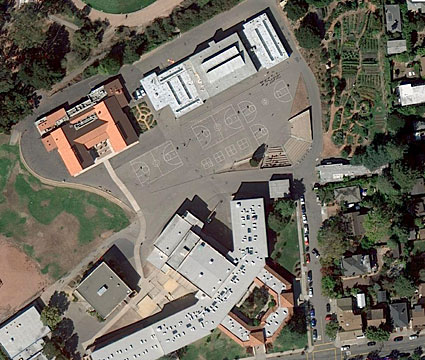 An aerial view of Martin Luther King, Jr. Middle School in Berkeley, with its large Dining Commons (top left) and Edible Schoolyard gardens (top right).After school kitchen and food improvements were included in the ballot question, the Center for Ecoliteracy and Alice Waters’ Chez Panisse Foundation campaigned actively for it. The bond measure, which voters approved by an overwhelming margin of 83 percent, slated more than $11 million for new kitchen and cafeteria construction, including a central kitchen that would prepare food for the entire district and a new dining hall at Martin Luther King, Jr. Middle School.
An aerial view of Martin Luther King, Jr. Middle School in Berkeley, with its large Dining Commons (top left) and Edible Schoolyard gardens (top right).After school kitchen and food improvements were included in the ballot question, the Center for Ecoliteracy and Alice Waters’ Chez Panisse Foundation campaigned actively for it. The bond measure, which voters approved by an overwhelming margin of 83 percent, slated more than $11 million for new kitchen and cafeteria construction, including a central kitchen that would prepare food for the entire district and a new dining hall at Martin Luther King, Jr. Middle School.
Bates said it was the only school in the system that really had room for such a facility. But it also happened to be where Alice Waters had built her Edible Schoolyard to teach children about gardening, about where food comes from and how to enjoy meals cooked with fresh, seasonal ingredients. (Watch this video tour of the Edible Schoolyard.)
The new marching orders for food service included not only fresh foods but ingredients that were “as organic as possible.” There would be salad bars at every school. New policies eliminated sodas, vending machines, and snack bars, except for a new “healthy snack bar” at the high school. Parents insisted on ridding school food of high-fructose corn syrup as well. Chocolate milk was out; organic plain milk was in.
It wasn’t exactly clear how cooking from scratch would be affordable. Weren’t fresh ingredients more expensive? Advocates were banking on greater student participation in the revamped meal program to cover the costs. “The food cost is high,” acknowledges Weaver. “But if you’re selling twice as many lunches, the marginal cost is lower.”
Next came a decision about who would run a revamped food operation in which meals would be prepared from scratch in a central kitchen. There was no consensus that the schools should be springing for a professional chef.
Alice Waters, however, had someone in mind.
Waters had met chef Ann Cooper when she toured the Ross School, an exclusive school in New York’s Hamptons, where Cooper, a former restaurant chef and dynamo advocate of healthy school food, was running food service. Cooper was planning to leave the school and take a “100-day vacation” to think about what she wanted to do next. She and Waters met again at a seafood sustainability conference in Monterey, Calif., and slipped away to Waters’s hotel room for breakfast, where Waters asked Cooper to move to Berkeley and take over as the new food services director.
No, said Cooper.
“I said I didn’t want to deal with day-to-day stuff,” Cooper explains. “I don’t really know public schools. Instead, we agreed I would come on as a consultant to help make the change. I’d do an assessment.”
Waters agreed to pay Cooper a “$100,000-ish” fee through the Chez Panisse Foundation. Cooper wanted to use the money that the school system would have paid her as food services director to create three new positions for the central kitchen: executive chef and two sous chefs, one to run kitchen production and another to handle food procurement.
It was a bumpy transition.
“In defense of all these food service people across the country, we’ve had this system for the last three decades and the USDA has been supporting it. Then a chef comes in and says, ‘This is not good food, we shouldn’t be serving it to kids, the guidelines are wrong, the USDA is wrong, and you are wrong. That’s a very difficult change to make,” Cooper recalls. “So I have a lot of empathy for these people who’ve been trying to do the right thing. It’s very, very hard to make those changes, emotionally.
“It was really hard for a number of reasons. My entire background was being a chef. At Ross School, it was still like being a chef. We had a large budget, and we were cooking really fine food and catering. I went to Berkeley and there were challenges with me being caught between the Chez Panisse Foundation and school food services. It wasn’t happening as fast as Alice would like. There was a lot of pushback from the employees and from the kids. In a school district, you have thousands of bosses. All of a sudden, not only are you not omnipotent, you have to change the way you do things. Before, you didn’t have to beg people for money, you didn’t have to beg kids to eat your food.”
Eric Weaver says Cooper worked “like the Energizer Bunny. She was always working. She never sleeps.”
Cooper says, “It was the hardest thing I’ve ever done. A lot of my friends thought I was going to kill myself because I was literally working around the clock.”
Not an easy change to swallow
Until construction of the $8 million Dining Commons and its new kitchen on the Martin Luther King Jr. Middle School campus, the central kitchen where Cooper would work initially was located in cramped quarters at an elementary school. “It was a hell hole,” says current Executive Chef Bonnie Christensen. Meanwhile, Cooper said she had meetings with food service employees who shouted at her that the kids hated the new food, and they didn’t want to serve it. Some of them went to the food services director “in tears.”
But there came a time when the entire crew moved into their new digs in the Dining Commons. In the huge new kitchen, there were six walk-in refrigerators and a freezer, seeming miles of work tables and sinks, griddles, grills, convection ovens, a combination steamer-roaster, a big kettle cooker, a tilt skillet, and a room with commercial dishwashers.
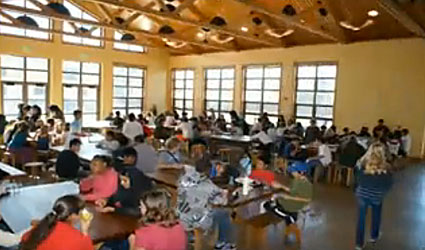 Students in the MLK, Jr. Dining CommonsWeaver says the new facility is “a little overdone.” The tables and chairs for the dining room, for instance, were commissioned from Wowhaus, an arts collaborative in Sonoma County that “explores the common denominators of everyday experience, the central question of how things, places and relationships acquire meaning” through sculptures, murals and furniture.
Students in the MLK, Jr. Dining CommonsWeaver says the new facility is “a little overdone.” The tables and chairs for the dining room, for instance, were commissioned from Wowhaus, an arts collaborative in Sonoma County that “explores the common denominators of everyday experience, the central question of how things, places and relationships acquire meaning” through sculptures, murals and furniture.
“Alice had this idea of kids growing their own food, cooking their own food. The kitchen would have looked like Chez Panisse,” says Weaver. “But without her pushing and pushing, it never would have happened the way it did.” Still, the spa-like Dining Commons has created some conflict within the school system. “Everything is so wonderful at King, and not so wonderful at other schools.”
Christensen says some of the equipment in the old kitchen was actually bigger and better. But now the chefs at least had room to stretch their wings. The new and improved Berkeley central kitchen was ready to fly.
Next: How seasoned chefs make cooking from scratch a reality.
Watch a video tour of the King Dining Commons with Ann Cooper:
